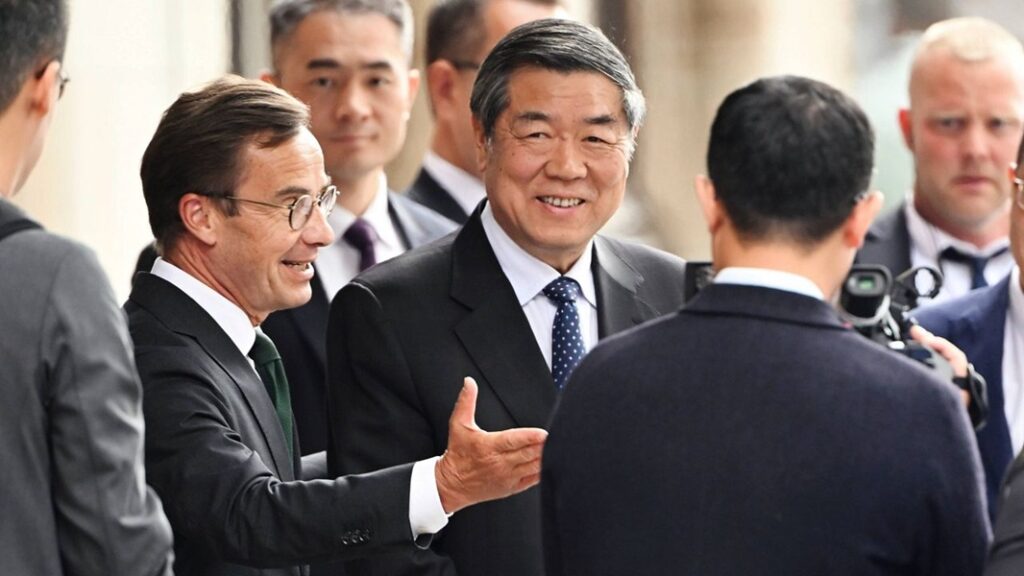WASHINGTON – Top officials from the United States and China are meeting in Stockholm this week for a pivotal round of U.S.-China trade talks, with both sides expected to hold tariffs steady while working toward a potential summit between Presidents Donald Trump and Xi Jinping later this year.
Treasury Secretary Scott Bessent and Chinese Vice Premier He Lifeng are set to convene Monday for their third meeting this year. The talks come four months after Trump shook global markets by imposing a sweeping tariff regime, including a spike in import taxes on Chinese goods that reached up to 145%.
“We have the confines of a deal with China,” Trump said Friday before departing for Scotland, suggesting optimism about progress.
Tariffs at the Forefront
Bessent told MSNBC that earlier discussions in Geneva and London had led to a “status quo” in tariff levels: the U.S. currently applies a 30% tariff on Chinese imports, while China maintains a 10% rate, in addition to existing pre-2021 tariffs. Bessent emphasized that the next step is addressing the long-running U.S. trade deficit, which stood at $295.5 billion last year.
“The goal is to bring more balance to the economic relationship,” Bessent said, pointing to U.S. efforts to increase exports to China and push Beijing toward a consumer-driven growth model.
The Chinese Embassy in Washington signaled cautious optimism, expressing hope for “more consensus and cooperation and less misperception” in the wake of the meeting.
Eyes on a Trump-Xi Summit
The talks in Sweden may serve as a precursor to a fall summit between the two leaders. Wendy Cutler, a former U.S. trade negotiator and now vice president at the Asia Society Policy Institute, said Beijing would likely insist on “detailed preparations” before committing to a high-level meeting.
She added that Stockholm could set the stage for announcements on key issues such as China’s industrial overcapacity and its regulation of fentanyl precursor chemicals—major irritants in U.S.-China relations.
Sean Stein, president of the U.S.-China Business Council, noted that business leaders are closely watching the tone of the discussions and signals about whether a presidential summit is truly on the horizon.
AI Manipulation: What My Failed Podcast Taught Me About Trust and Transparency

Fentanyl Tariffs and Chemical Controls
One of the most contentious issues remains the U.S. decision to impose a 20% fentanyl-related tariff earlier this year, citing China’s failure to curb chemical exports used in illicit drug production. This built on an earlier 10% tariff introduced in February, which Beijing countered with levies on coal, LNG, beef, and soybeans.
Although both sides scaled back three-digit tariffs after the so-called “Liberation Day” tariffs in April, the U.S. retained its fentanyl-linked duties, prompting China to hold its 10% retaliatory rate. Further negotiations in London centered on non-tariff issues such as export controls, but no changes to tariff rates were made.
Despite longstanding tensions over fentanyl, China took a significant step in July by placing two fentanyl precursor ingredients under stricter regulatory control—widely interpreted as a goodwill gesture.
No Major Tariff Relief Expected—Yet
Gabriel Wildau, managing director at consulting firm Teneo, does not expect any immediate tariff rollbacks in Stockholm. However, he suggested that fentanyl-linked tariffs could be lifted as part of a broader deal, with final tariff levels likely falling in the 15–20% range seen in recent agreements with Japan and Vietnam.
Still, Wildau cautioned that China’s industrial overcapacity—especially in electric vehicles and emerging technologies—remains a growing geopolitical concern not just for the U.S., but also for Europe, Japan, and South Korea.
Chinese Premier Li Qiang acknowledged these concerns last week, stating, “Some people think this will cause new problems in the balance of supply and demand in world production. We see this problem too.”
Broader Strategic Tensions
Beyond trade, Bessent said discussions may also touch on China’s oil imports from Iran and Russia. However, Wildau noted that any U.S. push on that front could prompt Beijing to demand concessions on security issues—such as reducing American military presence in East Asia or easing support for Taiwan and the Philippines. Such trade-offs would likely face bipartisan resistance in Washington.
According to Wildau, the most realistic outcome of the U.S.-China trade talks in Stockholm is a limited agreement focused on fentanyl and symbolic economic concessions—rather than a comprehensive overhaul of the trade relationship.
“That,” he said, “is probably the preferred outcome for China hawks in the Trump administration, who worry that an overeager Trump might offer too much to Xi.”






